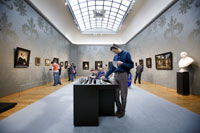Paintings of the Rijksmuseum > History of the collection
The Rijksmuseum was founded 1800 as the Nationale Konstgalerij (National Art Gallery). At the time, it was housed in Huis ten Bosch in The Hague. In 1808, the Rijksmuseum moved to the former Town Hall on the Dam Square in Amsterdam. There, the collection was expanded with paintings loaned from the City of Amsterdam, including Bartholomeus van der Helst’s Schuttersmaaltijd and Rembrandt’s Night Watch and De Staalmeesters. The Rijksmuseum’s standing was greatly enhanced when it purchased almost two hundred paintings from two private collections in 1808 and 1809. The collection’s emphasis came to lie on the seventeenth-century Dutch school of painting. In 1815, the museum was moved, together with the Royal Netherlands Academy of Arts and Sciences, to the Trippenhuis on the Kloveniersburgwal in Amsterdam. In the decades that followed, the collection expanded very little as there was no budget for new acquisitions. It was not until the Dupper legacy (in 1870) that additional paintings from the Dutch Golden Age arrived to enrich the Rijksmuseum Collection.
A new accommodation
In 1885, the Rijksmuseum moved again, this time to a building of its own, designed by the architect Pierre Cuypers especially for the purpose of housing a vast art collection. These are the premises that the Rijksmuseum occupies to this very day. From 1875 onwards the collection of paintings expanded steadily, thanks to donations, legacies and acquisitions. The numerous paintings received on loan from the City of Amsterdam (the many seventeenth-century masterpieces belonging to the Van der Hoop Collection, among them) nearly tripled the number of paintings in the new Rijksmuseum, from 700 works to 2000.
1900 and later

Around 1900, many of the museum’s acquisitions were made for their documentary value. Preference tended to be given to canvasses that had been dated and signed by such painters as had been unknown up until then. This practice allowed the Rijksmuseum to lay the foundation for a reconstruction of individual painters’ oeuvres. From 1900 onwards, the museum’s policy became more consciously oriented towards the acquisition of acknowledged masterpieces. After World War II, great care was taken in reinforcing the presence of early Netherlandish paintings within the Rijksmuseum Collection. In the post-war period, the museum depended less on donations, as more means and funds became available for acquisitions.
During these years, within the framework of its active exhibition policy, the Rijksmuseum paid a great deal of attention to undervalued aspects of Golden Age painting. With this objective in mind, the museum purchased paintings by Hendrick Goltzius, Pieter Codde, Cesar van Everdingen and Hendrick ter Brugghen. In addition, the museum bought a substantial number of classic seventeenth-century Dutch masterpieces, including large still-life canvasses by Floris van Dijck, Pieter Claesz and Willem Heda, as well as monumental landscapes by Aelbert Cuyp and Philips Koninck. It also acquired a series of characteristic works by late seventeenth-century, classicist and eighteenth-century painters. Whilst the post-war years were characterized by an emphasis on the acquisition of Dutch masters, more recently a number of canvasses by painters from outside the Netherlands have been purchased as well, including masterpieces by Jacob Jordaens, Claude Lorrain and Pietro Longhi.
